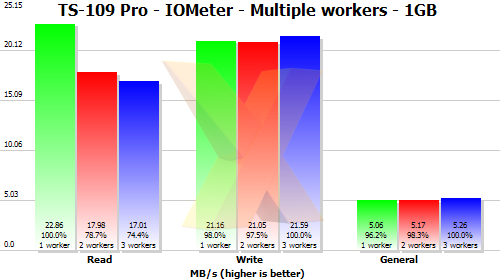Performance testing
Performance analysis
As with other NAS boxes we've tested, we broke out IOMeter and subjected the TS-109 Pro to our usual set of read/write and non-sequential tests.
This is the setup we used for testing.
Setup
| Component | Details |
|---|---|
| CPU | AMD Opteron 146 @ 2.5GHz |
| Motherboard | abit AN8 Ultra (nForce 4 Ultra) |
| Memory | 2GiB PC3200 DDR @ 209MHz |
| Disks | 4x Seagate 7200.8 250GB - RAID 10 |
| Graphics | NVIDIA GeForce 6800 GT 256MiB |
| Network | NVIDIA network controller, 1Gbps, 9000byte frames |
| OS | Microsoft Windows XP x64 |
We used a Maxtor 250GB 6V250F0 SATA drive within the TS-109 Pro and set the NAS box's jumbo-frame option to 9000bytes, except where stated otherwise.
Here are the tests run with IOMeter:
| Option/Test | Configuration |
|---|---|
| Outstanding I/Os | 10 |
| Individual test run time | 30 seconds |
| Read test access spec | 1MB transfers 100% sequential 100% read |
| Write test access spec | 1MB transfers 100% sequential 100% write |
| General usage access spec | 64KB transfers 50% sequential, 50% random 33% write, 67% read |
All IOMeter tests were run a minimum of three times, with three results taken and averaged (mean) for our graphing.
Results
Performance results for the TS-109 Pro are shown alongside those we obtained for two Thecus products. The Thecus N1200 is a similar product to the QNAP, the 1U4500, is a rack-mount storage devices for servers.
First up, here are some IOMeter read results.

We don't have data from the 1U4500 for file-sizes below 250MB because its massive 512MB memory was giving us nice, fast cached transactions. So results from the 1U4500 at 125MB and 62.5MB are likely to be similar to those we saw at 250MB.
Looking at the read performance of the two directly-comparable products - the QNAP TS-109 Pro and Thecus N1200 – it's clear that the QNAP holds a consistent and substantial lead.
Superficially, in the battle between Marvell ARM and Intel IOP, the ARM-powered TS-109 Pro wins.
However, although the CPU is one obvious distinguishing factor between the two boxes, it may not be what's limiting the N1200's read performance.
That could instead be the configuration of the operating system or a data-transfer issue within the architecture of the mainboard.
What's very interesting is that, for big file sizes in our synthetic testing, the TS-109 Pro out-performed the four-disk 1U4500. Eek!
You'd initially think that a four-disk device would always be faster, and indeed that is a fair assumption. But at the data rates we're observing, it's quite possible that the TS-109 is able to pull ahead.
Just think of the limiting factors and where the bottle-necks might be - in the case of these devices, it doesn't appear to be the disks.
Both boxes have gigabit Ethernet and that can handle about 90MB/s after overheads – if jumbo frames are on.
A single modern hard disk can handle upwards of 50MB/s sustained and an array of drives can handle even more.
So, if what's coming out of the 1U4500 is less than its drives can produce, there's got to be a bottleneck somewhere between the drives and the Ethernet port.
We can't be sure quite where that lies, but it does show that in some way, the TS-109 Pro is better configured for sustained data reads.

The tables turn when we start the sustained write cycles. The 1U4500 is in a class of its own and the N1200 out-performs the TS-109 at most file sizes, though not by a massive margin.
Write performance of the two single-drive boxes doesn't improve much when we get down to fully-cacheable file-sizes but there is a 3MB/s difference from 1GB down to 62.5MB for the TS-109 and a bigger, 8MB/s differential with the N1200.

To see what happens when you want to do something other than read/write massive files to/from these devices, we shrink the transfer size, add in some randomizing of the request and spread the requests between read and writes.
Once again, the 1U4500 keeps the single-disk NAS boxes in check. The N1200 out-performs the TS-109 Pro until we get down to smaller file sizes.
There's not a great deal in it but, perhaps, enough to sway your purchase-decision if you're going to be doing more over-the-network random accesses than streaming. But given the swap-over at lower file sizes, it's really a case of swings and roundabouts.

Throwing multiple IOMeter workers at the TS-109 Pro tests its ability to deal with multiple requests relating to the same file.
Above we can see the read performance taper off a little as we increase the worker count. For writes, the performance varies too much to say which way it's actually headed. General performance shows a slight increase, likely by virtue of the network being put to better use with the smaller transfer sizes for this particular test.
So if a few of you are hitting the TS-109, expect to get about 75% of the read performance, with write performance staying more or less the same.
It's interesting to see the TS-109 outpace a high-end RAIDed NAS in some situations yet and lose out to a fellow single-disk NAS device in others. All things considered, though, we reckon that the TS-109 Pro's performance is more than acceptable and largely in keeping with what we'd have hoped to see.









